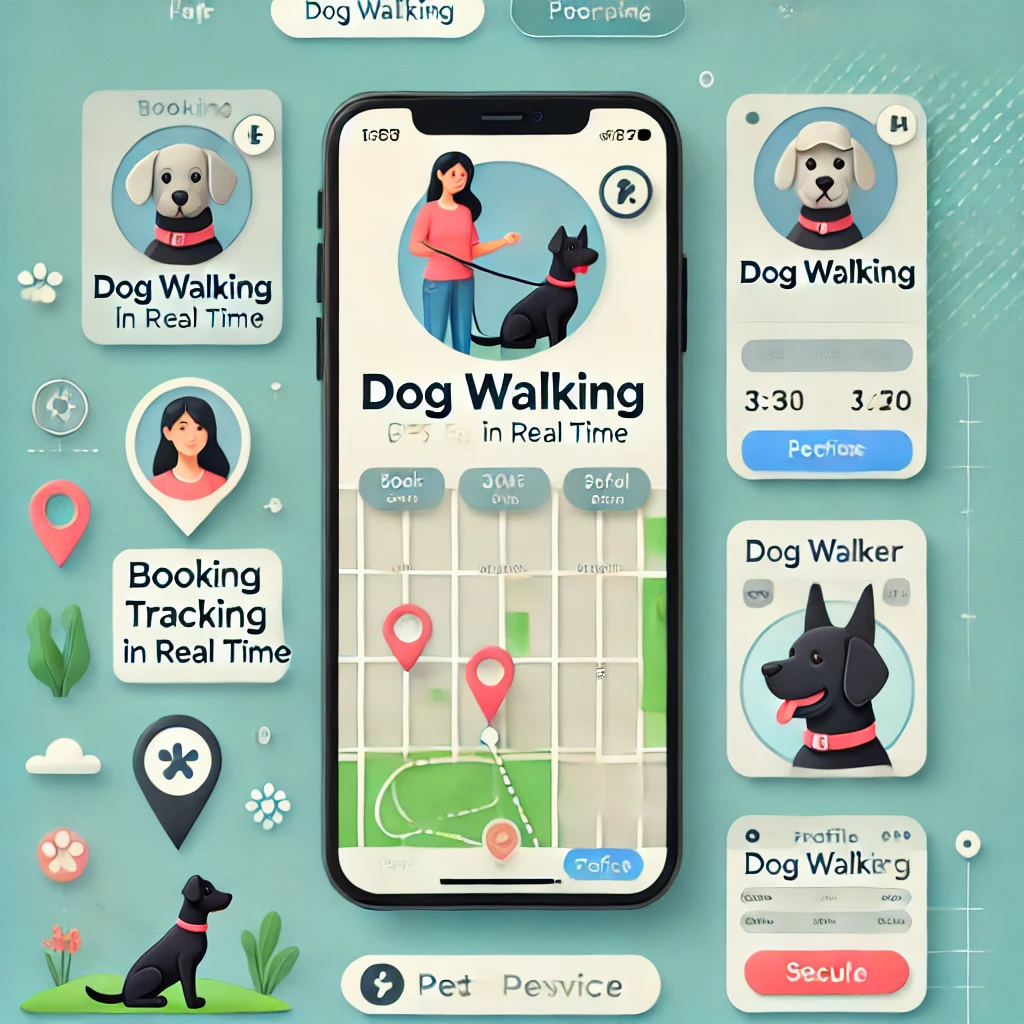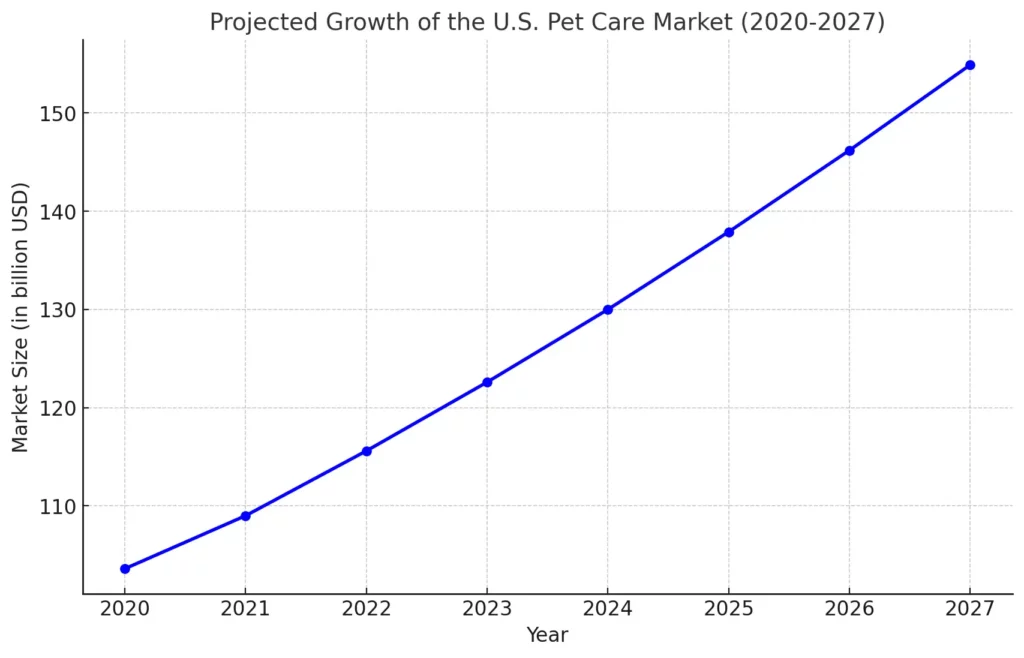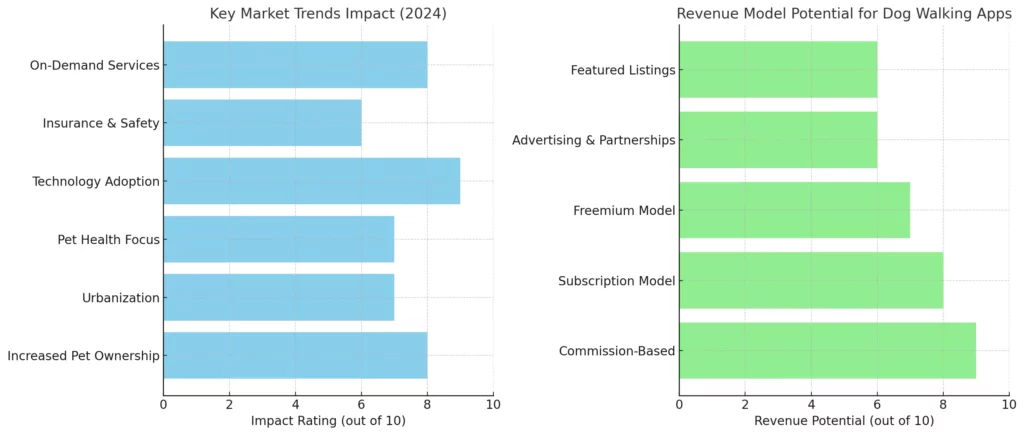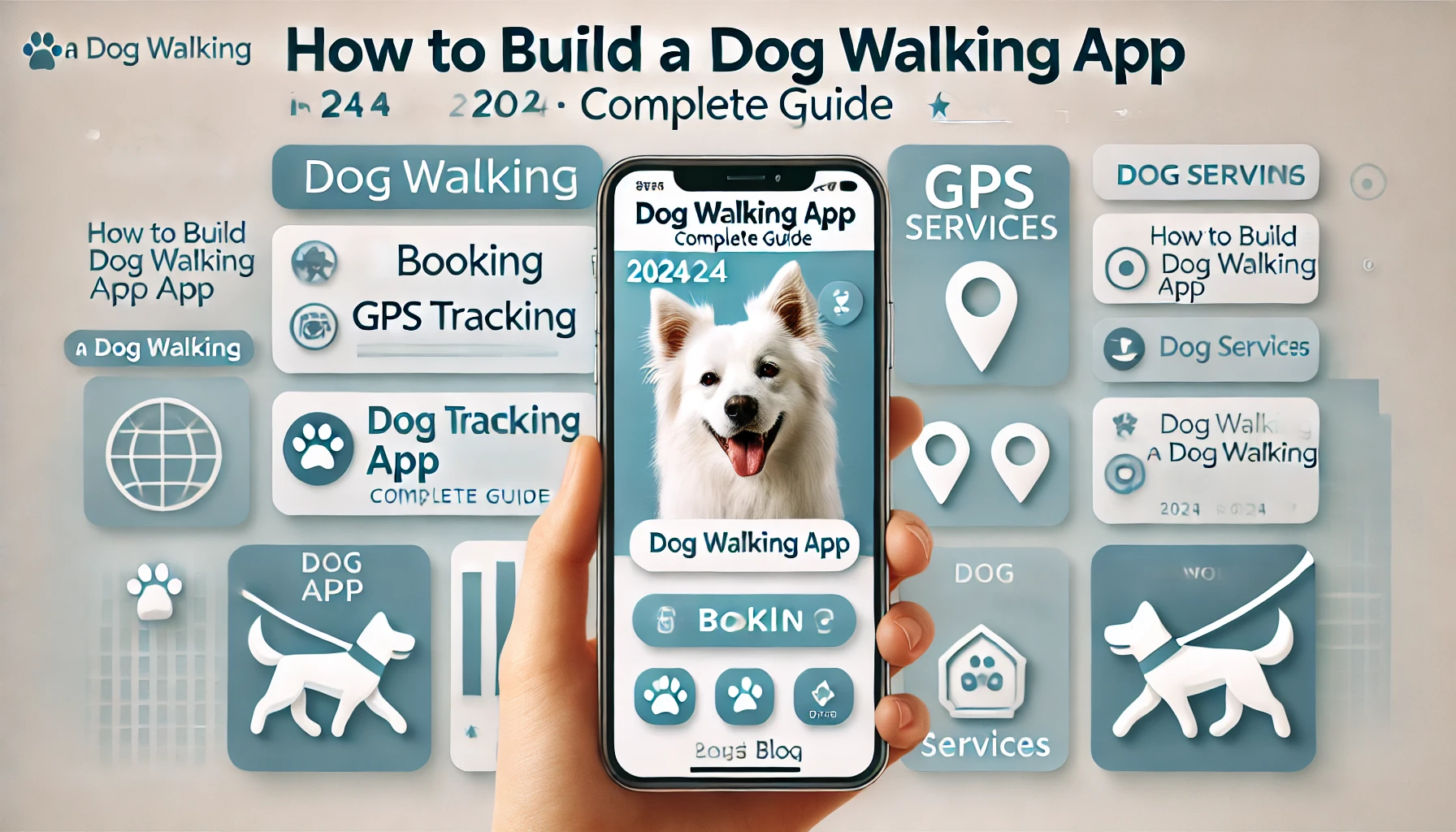With the pet care industry booming and dog walking services in high demand, 2024 presents a fantastic opportunity for entrepreneurs looking to build a dog walking app like rover. Whether you’re an experienced developer or a business owner ready to invest in the pet service market, creating a custom dog walking app could position you ahead of the competition. In this complete guide, we’ll walk you through everything you need to know, from design and essential features to launching your app for success.
Why Build a Dog Walking App in 2024?
The demand for dog walking services has surged as pet owners seek convenient and reliable ways to ensure their pets are cared for. Apps like Rover and Wag! have led the way in connecting dog owners with trusted walkers, offering a clear business model that can be expanded upon. By building a custom app, you can tap into this growing market, providing a platform for pet owners and walkers to connect while establishing your brand.
Detailed Introduction to Market Size and Demand
The pet care industry is booming, and the demand for dog walking services is on a sharp upward trajectory. According to a report by the American Pet Products Association (APPA), the U.S. pet industry reached $103.6 billion in 2020, with a significant portion attributed to pet services like dog walking, grooming, and boarding. Globally, the pet care market is projected to grow at a CAGR of 6.1% from 2021 to 2027, driven by increased pet ownership and a shift toward urban living where professional pet services are often necessary.

With apps like Rover and Wag! dominating the industry, there is still ample room for growth, particularly in niche markets or regions underserved by existing platforms. Entrepreneurs entering the dog walking app market in 2024 are well-positioned to capitalize on this expanding demand by offering tailored, localized services that meet the specific needs of their target audiences.
Market Trends for Dog Walking Apps (2024 and Beyond)
| Trend | Description | Impact on Market |
|---|---|---|
| Increased Pet Ownership | Surge in pet ownership, particularly among Millennials and Gen Z | High demand for pet services |
| Urbanization and Time Constraints | More people living in urban areas with busy schedules | Increased need for on-demand services |
| Focus on Pet Health and Wellness | Growing emphasis on regular exercise and fitness tracking for pets | High demand for health-oriented app features |
| Technology Adoption | Use of AI, GPS, and secure payment systems | Enhanced user experience and trust |
| Pet Insurance and Safety | Inclusion of pet insurance and walker safety features | Builds trust and reliability |
| On-Demand Services and Subscriptions | Users prefer on-demand, easy-to-use services | Adoption of subscription models |
The pet care industry continues to evolve, driven by shifts in consumer behavior, technological advancements, and increased urbanization. Below are some key market trends in the dog walking app space that are shaping the future of this sector:
- Increased Pet Ownership:
- Pet ownership, especially among Millennials and Gen Z, has skyrocketed. According to APPA, 67% of U.S. households owned a pet in 2020, with numbers continuing to rise.
- This increase in pet ownership has directly led to higher demand for pet-related services like dog walking, grooming, and sitting.
- Urbanization and Time Constraints:
- As more people move to urban areas, their busy lifestyles often leave them with little time to walk their dogs. The need for convenient, on-demand dog walking services has grown rapidly.
- Apps that offer quick, easy booking and real-time tracking are particularly attractive to urban pet owners.
- Focus on Pet Health and Wellness:
- Health-conscious pet owners are prioritizing the wellness of their pets, which includes regular walking. Features like real-time GPS tracking and fitness reports in apps help dog owners monitor their pet’s health.
- The rising trend of fitness tracking for pets is becoming a selling point for many dog walking apps.
- Adoption of Technology:
- The integration of AI, GPS tracking, and secure payment systems has improved the overall user experience in dog walking apps. AI is also being used to personalize experiences, such as suggesting preferred routes or matching walkers to pets based on behavior and preferences.
- Pet Insurance and Safety:
- Pet insurance is becoming a must-have, and apps are starting to include insurance coverage for pet services. Apps that offer additional safety features like walker background checks and emergency contacts are gaining more traction.
- On-Demand Services and Subscriptions:
- On-demand dog walking services are growing rapidly, with companies adopting subscription-based models to offer pet owners access to premium services like unlimited walks and priority bookings.

Feature Deep Dive
| Feature | Importance | Implementation Tips |
|---|---|---|
| Booking System | Enables users to schedule and manage dog walking | Use a calendar-based system; build with Node.js or Laravel for backend |
| Real-Time GPS Tracking | Builds trust by letting owners track walks in real-time | Use Google Maps API or Mapbox for accurate tracking |
| Secure Payments | Simplifies transactions and improves security | Integrate Stripe or PayPal for secure payment processing |
| Ratings & Reviews | Helps build trust in the dog walking community | Use Algolia or Elasticsearch for scalable review systems |
| Push Notifications | Keeps users informed of bookings, promotions | Implement using Twilio API for real-time notifications |
| In-App Chat | Facilitates communication between owners and walkers | Leverage chat APIs like SendBird or Twilio Chat |
Essential Features for a Successful Dog Walking App and How to Build Them
Building a dog walking app requires incorporating the right features to create a seamless experience for both pet owners and walkers. Here’s a breakdown of the most important features and how to implement them:
- Booking System:
- Allow users to easily schedule walks through an intuitive booking interface. Use a calendar-based system with real-time availability to streamline the process.
- Implementation Tip: Use a backend framework like Node.js or Laravel to manage bookings and allow for notifications via APIs.
- Real-Time GPS Tracking:
- Real-time GPS tracking builds trust by allowing pet owners to monitor their dog’s walk in real-time. The tracking feature should show live updates and route history.
- Implementation Tip: Leverage Google Maps API or Mapbox to integrate accurate real-time tracking into your app.
- Secure Payments:
- Integrate secure payment gateways like Stripe or PayPal to ensure users can pay for services directly through the app.
- Implementation Tip: Include options for automatic billing or pay-per-walk to give users flexibility.
- Ratings & Reviews:
- User-generated reviews help build a community of trust. Ensure that both pet owners and walkers can leave ratings and reviews to enhance service quality.
- Implementation Tip: Use Algolia or Elasticsearch for scalable and fast review systems.
Steps to Build a Dog Walking App in 2024
Step 1: Research & Planning
Define Your Niche
Before jumping into development, it’s crucial to define your niche within the dog walking industry. Do you want to focus solely on dog walking, or would you like to include additional services like dog sitting, training, or pet adoption? Research successful apps like Rover and Wag! and consider what unique features you can offer, such as a doggy dating app or a specialized dog walking app to make money.
Understand Your Audience
Pet owners are your target audience, but within this group, there are varying needs. For example, some users may need dog walking services, while others could be looking for dog sitter apps or even apps for dog adoption. Understanding these distinctions will allow you to design an app that caters to a broad market, making it more versatile.
Step 2: Designing the App
Create a User-Friendly Interface
Your app’s interface should be intuitive and user-friendly. It needs to attract both pet owners and walkers, with straightforward navigation, simple booking options, and profile management tools.
– Pet Owner Profiles: Include features for adding pet details, preferences, and vet information.
– Dog Walker Profiles: Allow walkers to create profiles that show their qualifications, reviews, and availability.
You can also use AI tools to design a dog walking business logo with AI, giving your brand a modern and professional look.
Incorporate Essential Features
Booking System: Develop a seamless booking system for users to easily schedule and manage appointments.
– Utilize dog walking software to streamline scheduling and payment processing.
– Consider adding a doggy tinder feature to help dog owners find walkers they connect with.
Real-Time GPS Tracking: This feature allows dog owners to track their pet’s walks in real-time, increasing trust and transparency.
Secure Payments: Integrate secure payment methods, making it easy for users to pay for services directly through the app.
Ratings & Reviews: Implement a review system where pet owners can rate dog walkers, building a community of trust.
Push Notifications: Keep users informed about appointments, promotions, and any updates with timely notifications.
Step 3: Development & Technology Stack
Choosing the Right Platform
Start by deciding whether you want to develop a native app for iOS and Android or go for a cross-platform solution. Native apps generally offer better performance but may require more resources. Cross-platform frameworks like Flutter and React Native allow you to deploy your app on multiple devices with a single codebase, saving time and money.
Backend & APIs
To manage bookings, payments, and GPS tracking, you will need a robust backend. Popular backend frameworks like Node.js or Laravel can support the app’s needs, while third-party APIs can handle features like real-time GPS, payment gateways, and chat systems.
Integrating AI and Machine Learning
AI can personalize the user experience by suggesting best apps for dog walking business or creating a dog walking business logo with AI. Machine learning can help improve search results and recommend the best dog walkers based on user preferences.
Step 4: Monetization Strategies
Subscription Plans
Offer subscription plans to dog owners for premium features such as unlimited walks, priority booking, and premium support.
Commission Model
Like other apps for dog walking, you can charge a commission for every booking made through the app. This model has been proven to work for apps like Rover.
In-App Advertising
Collaborate with pet-related businesses for in-app advertising. Promote pet supplies, dog foods, or even partner with companies offering dog sitter advertisements.
Featured Listings
Offer walkers the option to pay for premium listings that appear at the top of search results, similar to how Rover dog sitting app and walk dogs app operate.
Step 5: Marketing Your Dog Walking App
Create a Strong Online Presence
Build a website using popular websites for creating dog walking booking services. Make sure to incorporate SEO techniques and optimize for keywords such as how to create a dog walking booking website and how to make a dog walking website.
Social Media Campaigns
Launch social media campaigns focusing on dog owners. Use platforms like Instagram and Facebook to share stories about happy pets and satisfied customers.
Referral Programs
Offer incentives to users who refer new pet owners or dog walkers. This strategy will help grow your user base quickly and organically.
Step 6: Launching & Scaling
Beta Testing
Conduct beta testing with a small group of users to iron out any bugs and gather valuable feedback. This process is crucial for ensuring a smooth user experience once you go live.
Launch in Multiple Cities
Start by launching in a single city or region before expanding. This will allow you to scale operations efficiently and test different marketing strategies.
Development Cost of a Custom Dog Walking App
Building a custom dog walking app from scratch can be a significant investment, depending on the features, platforms, and complexity of the app. The cost of development varies based on the scope of the project, the location of the development team, and the specific features you want to include.
Here’s a detailed breakdown of the development costs for a custom dog walking app:
Custom Dog Walking App Development Cost Breakdown
| Feature/Task | Description | Estimated Cost Range |
|---|---|---|
| App Design (UI/UX) | Creating a user-friendly interface and design for both web and mobile apps. | $3,000 – $6,000 |
| App Development (iOS & Android) | Developing the mobile app for iOS and Android, including core functionality like GPS tracking, booking, and payments. | $15,000 – $30,000 |
| Backend Development | Building the server-side logic, API integration, and database management. | $8,000 – $15,000 |
| Web Platform Development | Creating a web version of the app for desktop users, including dashboards and bookings. | $6,000 – $10,000 |
| Payment Integration | Integrating secure payment gateways like Stripe, PayPal, etc. | $2,000 – $4,000 |
| GPS & Mapping Integration | Adding GPS tracking and map-based functionality for dog walking routes. | $3,000 – $5,000 |
| Push Notifications | Enabling real-time notifications for walk updates, bookings, and payments. | $1,500 – $3,000 |
| User Profiles & Reviews | Creating user accounts, dog profiles, and review systems for walkers. | $2,500 – $4,500 |
| Admin Dashboard | A central admin panel for managing bookings, payments, and users. | $3,000 – $6,000 |
| Testing & QA | Ensuring the app functions smoothly on all platforms and fixing bugs. | $2,000 – $5,000 |
| App Deployment | Deploying the app to the App Store (iOS) and Google Play (Android). | $500 – $1,000 |
| Maintenance & Support | Ongoing updates, bug fixes, and feature enhancements post-launch. | $1,000 – $3,000 per month |
Total Estimated Development Cost:
- Basic App: $35,000 – $50,000
- Medium-Complexity App: $50,000 – $80,000
- Advanced App: $80,000+
Factors Affecting the Cost:
- Feature Complexity: Advanced features like AI-based recommendations, multi-currency payment systems, or video calls for virtual dog sitting can drive costs higher.
- Platforms: Developing for both iOS and Android adds cost compared to a single platform.
- Development Team Location: Developers in regions like North America and Europe tend to charge higher rates compared to those in South Asia or Eastern Europe.
- Third-Party Integrations: The use of third-party APIs for features like GPS tracking or payment gateways can also impact the overall cost.
Get a Complete Dog Walking App Solution with Miracuves for Just $2499
If you’re looking to start a dog walking business with an app, Miracuves Solutions offers a ready-made, feature-packed solution for both web and mobile apps. For just $2499, you can launch a fully functional dog walking app that rivals industry leaders like Rover and Wag.
Our dog walking app solution is designed to meet the growing needs of dog owners and walkers. With features like GPS tracking, real-time notifications, secure payments, and walker reviews, you’ll have everything you need to build a scalable and profitable business.
Whether you’re an individual looking to manage a small client base or a business wanting to expand your services, Miracuves’ solution provides flexibility, reliability, and robust functionality, all at an affordable price.
Read More “Top 10 High-Demand Ideas for Pet Care and Grooming Business Startup“
Features Included in the Dog Walking App Solution:
| Feature | Description | Included |
|---|---|---|
| Web & Mobile App | Get both a website and mobile apps (iOS/Android) for easy access. | ✅ |
| GPS Tracking | Real-time tracking of dog walks, with route mapping. | ✅ |
| Scheduling & Booking System | Allow clients to book, reschedule, and cancel appointments easily. | ✅ |
| Secure In-App Payments | Integrate secure payment gateways like Stripe or PayPal. | ✅ |
| Push Notifications | Notify clients when their dog is picked up, walked, and dropped off. | ✅ |
| Walker Profiles & Reviews | View detailed profiles and ratings for dog walkers. | ✅ |
| Dog Profiles | Store information about each dog, including health and preferences. | ✅ |
| Admin Dashboard | Manage all users, bookings, and payments from a single dashboard. | ✅ |
| Customization Options | Easily customize branding, colors, and features. | ✅ |
| One-Time Payment | Pay just $2499 with no hidden fees or ongoing subscription costs. | ✅ |
Revenue Model for Dog Walking Apps
| Revenue Model | How It Works | Example |
|---|---|---|
| Commission-Based | The platform takes a percentage of every transaction between owners and walkers | Rover and Wag! take 10-20% commission on bookings |
| Subscription Model | Users pay a monthly or yearly fee for premium features and services | $9.99/month for unlimited walks, priority bookings |
| Freemium Model | Basic features are free, but premium features are behind a paywall | Free GPS tracking, but video updates are premium |
| Advertising and Partnerships | The app generates revenue through ads or partnerships with pet-related companies | Sponsored content from pet food or insurance brands |
| Featured Listings for Dog Walkers | Dog walkers pay to have their profiles ranked higher in search results | Dog walkers pay $10/month for premium visibility |
Creating a sustainable revenue model is essential for the long-term success of a dog walking app. Below are some common revenue models in the dog walking app industry:
1. Commission-Based Model
- Apps like Rover and Wag! typically charge a commission on each transaction between dog owners and walkers.
- How It Works: The platform takes a percentage of every booking (usually between 10% to 20%) as a service fee.
- Example: If a dog walker charges $20 for a walk, the platform takes a $2 to $4 commission.
2. Subscription Model
- Some apps offer premium subscription plans for dog owners, which provide additional benefits like priority bookings, discounts on walks, and exclusive features such as video updates or fitness reports.
- How It Works: Users pay a monthly or yearly fee for premium access to the platform’s best services.
- Example: An app may offer a $9.99/month subscription for unlimited walks and priority scheduling.
3. Freemium Model
- A freemium model offers basic services for free but charges for premium features. Basic features include booking and GPS tracking, while premium features may include advanced safety features, fitness tracking, and insurance.
- How It Works: Users get basic services for free but are charged for unlocking advanced features through in-app purchases.
- Example: Free users can book walks, but premium users get GPS tracking and pet insurance for a small fee.
4. Advertising and Partnerships
- Dog walking apps can generate revenue through sponsored content, ads, or partnerships with pet product companies. For example, apps can promote pet insurance services or sell space for advertising pet-related products like food, toys, and accessories.
- How It Works: Advertisers pay the platform to display their products or services in the app.
- Example: Partnering with a pet insurance company to offer policies to dog owners through the app.
5. Featured Listings for Dog Walkers
- Dog walkers can pay to have their profiles featured more prominently in search results, increasing their chances of getting booked.
- How It Works: The app charges a fee to dog walkers for higher visibility on the platform.
- Example: A dog walker might pay $10 a month to have their profile appear at the top of local searches.
Possible Market Penetration Strategies for a Dog Walking App

To successfully enter the competitive dog walking app market, it’s essential to implement effective market penetration strategies. Below are some proven approaches that can help maximize user acquisition, brand visibility, and overall app success:
1. Localized Marketing Campaigns
- Focus on Initial Launch in Target Cities: Instead of launching globally, focus your marketing efforts on specific, high-demand cities where pet ownership is high, and dog walking services are in demand.
- Leverage Hyperlocal Marketing: Target local pet owners with ads and campaigns that highlight local parks, dog-friendly businesses, and community events. This can include advertising on platforms like Google Local Services Ads or community apps like Nextdoor.
- Neighborhood Events: Sponsor or host local pet events, dog meetups, or walking clubs in popular neighborhoods to raise awareness of your app.
2. Strategic Partnerships and Collaborations
- Partner with Pet Stores and Veterinarians: Collaborate with local pet stores, veterinary clinics, grooming services, and pet food brands. Offer special discounts or incentives for users who book dog walks through your app when they visit these locations.
- Collaborate with Pet Influencers: Leverage pet influencers and pet communities on platforms like Instagram and TikTok. Influencers can provide authentic endorsements and drive user engagement through social proof.
3. Referral and Incentive Programs
- Referral Rewards: Launch a referral program where users earn credits or discounts for referring new dog walkers or pet owners to the app. This helps spread the word through word-of-mouth marketing and incentivizes early adopters to grow your user base.
- First-Walk Free: Offer first-time users a free walk to experience the service without any upfront cost. This tactic can convert trial users into long-term customers.
- Dog Walker Incentives: Offer additional benefits, such as signing bonuses or higher commission rates for the first few bookings to attract experienced dog walkers.
4. Social Media Marketing and Community Building
- Targeted Social Media Ads: Use Facebook, Instagram, and TikTok ads to reach pet owners, dog lovers, and walkers. Target ads based on interests (e.g., pets, dogs, walking) and demographic data to ensure they reach the right audience.
- User-Generated Content: Encourage users to share photos or videos of their pets using your app with hashtags, offering them incentives or chances to be featured on your social channels. This builds brand engagement and trust within the pet owner community.
- Online Communities and Groups: Become an active participant in dog-related online communities, forums, and Facebook groups to promote your app organically.
5. Leverage SEO and Content Marketing
- Target High-Intent Keywords: Optimize your website and landing pages for SEO by targeting relevant, high-intent keywords like “best dog walking apps”, “dog walking app to make money”, or “apps for dog walkers”. This helps your app rank for organic search and attract users already looking for similar services.
- Educational Content: Create blog posts, guides, and how-to articles related to pet care, dog walking tips, and pet health. Example topics include “How to Start a Dog Walking Business” or “Benefits of Regular Walks for Dogs”. This positions your brand as an authority and helps drive traffic.
- Localized SEO: Ensure your website is optimized for local search queries, such as “dog walking services in [city]” or “best pet sitters near me”, to attract users from specific regions.
6. Offer Unique Features and Differentiate from Competitors
- Unique Value Propositions: Differentiate your app by offering features that competitors don’t, such as eco-friendly walking routes, dog fitness tracking, or a doggy dating feature. Unique offerings can make your app stand out and attract niche markets.
- Customization and Personalization: Use AI and machine learning to personalize the app experience. For example, offer route recommendations based on the dog’s walking preferences or match dog walkers and dogs based on behavior and compatibility.
7. Loyalty and Subscription Programs
- Reward Long-Term Users: Implement a loyalty program where users earn points or discounts after a certain number of walks or bookings. This keeps users engaged and coming back.
- Subscription-Based Premium Services: Offer premium memberships with benefits like priority bookings, unlimited walks, or real-time video updates for dog owners who want more control over their pet’s care.
8. App Store Optimization (ASO)
- Optimize for Search in App Stores: Ensure that your app’s title, description, and keywords are optimized for search within the App Store and Google Play Store. Use relevant keywords like “dog walking apps”, “dog walking business app”, and “get paid to walk dogs” to rank higher.
- Positive Reviews and Ratings: Encourage satisfied users to leave positive reviews. Apps with higher ratings and better reviews tend to rank higher and gain more visibility.
9. Partner with Dog-Walking and Pet-Related Events
- Sponsor Dog Walkathons and Competitions: Team up with animal shelters or pet adoption centers to sponsor dog walkathons, fun runs, or pet adoption events. Promote your app at these events and offer special discounts to participants.
- Pet Expos and Trade Shows: Attend pet-related expos and trade shows to showcase your app and network with potential partners, dog walkers, and service providers.
10. Paid Advertising and Retargeting
- Google Ads and Paid Search: Invest in Google Ads to ensure your app appears when users search for terms like “dog walking services near me” or “apps for walking dogs.”
- Retargeting Campaigns: Use retargeting to bring back visitors who have shown interest in your app but haven’t signed up yet. This helps increase conversions and drives app downloads.
Read More “7 Dog Walking Best Pet Care App Development 2024“
Competitive Analysis of Existing Dog Walking Apps
| App | Strengths | Weaknesses | Key Takeaways |
|---|---|---|---|
| Rover | Large user base, trusted by millions, real-time GPS tracking | Service quality can be inconsistent | Offer more personalized services for niche markets |
| Wag! | On-demand service, instant booking, same-day availability | Higher pricing compared to competitors | Competitive pricing and thorough vetting of walkers |
| Local Niche | Personalized, tailored to local communities | Limited scalability and advanced features | Combine personalization with advanced technology |
Top Dog Walking Apps of 2024 and What You Can Learn From Them
As you plan your dog walking app, it’s essential to study the competition and understand what sets the most successful platforms apart. Here are some key players in the dog walking industry:
- Rover:
- Strengths: Rover is the leading platform for dog walking and pet sitting services, boasting an easy-to-use interface, advanced GPS tracking, and a comprehensive vetting process for walkers.
- Weaknesses: While Rover covers a broad market, it can sometimes feel impersonal. Some users report inconsistent service quality due to the large number of walkers on the platform.
- Key Takeaway: Building a more personalized user experience and providing locally tailored services could help you differentiate from a larger, more generalized platform like Rover.
- Wag!:
- Strengths: Known for its “on-demand” service model, Wag! offers fast, reliable dog walking with features like instant booking and same-day service availability.
- Weaknesses: Wag!’s pricing structure has been criticized for being higher than its competitors, and like Rover, it faces challenges with consistency in service quality.
- Key Takeaway: Offering competitive pricing and a rigorous vetting process for walkers can give your app a competitive edge in the market.
- Local & Niche Apps:
- Strengths: Smaller, region-specific apps focus on personalized service and often cater to niche markets, such as seniors, disabled pets, or eco-friendly dog walking services.
- Weaknesses: They often lack the scalability and robust feature sets of larger competitors, such as GPS tracking or in-app payments.
- Key Takeaway: Combining the personalized approach of niche apps with the advanced features of larger platforms can help you appeal to both local markets and a wider user base.
By understanding what makes these apps successful, you can build a dog walking app that addresses their weaknesses while capitalizing on their strengths.

Regulations and Compliance Section
Navigating Regulations and Compliance for Your Dog Walking App
Creating a dog walking app requires more than just a great user interface and a reliable network of walkers. Pet service businesses must comply with local and regional regulations, including licensing, insurance, and safety standards.
- Walker Licensing: Depending on the location, dog walkers may need to be licensed to provide services. Ensure your app allows walkers to upload necessary certifications and conduct background checks to vet their qualifications.
- Insurance Requirements: Offering insurance coverage for dog walkers and owners is critical. Partnering with insurance companies to offer in-app coverage can protect both walkers and owners in the case of an accident or injury.
- Pet Safety Protocols: Establish clear safety guidelines for walkers and pet owners, including leash laws, emergency contact information, and guidelines for handling aggressive dogs.
By addressing compliance from the start, your app can build trust with users and avoid legal pitfalls.
Success Stories/Case Studies
Success Story: How Sarah Built a Profitable Dog Walking App in 2023
Sarah, a pet lover from Los Angeles, saw the growing demand for personalized pet services in her area. With a passion for technology, she teamed up with a development agency to build PawSteps, a dog walking app focused on eco-friendly, local dog walking services. After conducting extensive research and focusing on a niche market, Sarah’s app grew rapidly in her city. Within a year, she had 500 active users, with 200 daily bookings, generating over $10,000 in monthly revenue.
Her success was driven by personalized features like green walking routes, a subscription model for eco-conscious pet owners, and partnerships with local pet stores. Her story demonstrates that with the right approach, even niche apps can flourish. one more important aspects was Push notfications.
Features like pee, poo, and food/water alerts can be crucial for dog owners who want to stay informed about their pets’ needs throughout the day. Similar to the Wag app, you can integrate easy options to book and pay within the app, ensuring a seamless experience. Providing a Rover guarantee or equivalent service can also increase trust, especially for new users, while attracting dog people who value reliability and comprehensive pet care services.
Monetization Deep Dive
| Monetization Model | Description | Example | Potential Earnings |
|---|---|---|---|
| Freemium Model | Free basic features, paid premium features | Free GPS, premium video updates for $4.99/month | $5/month per user for premium features |
| Commission-Based | Percentage of each booking transaction | 15% commission on each walk costing $20 | $3 per booking |
| Subscription Model | Paid membership for unlimited walks or priority | $9.99/month subscription for unlimited walks | $10/user/month |
| In-App Advertising | Partner with brands for advertising space | Display pet food or insurance ads within the app | Varies depending on ad agreements |
| Featured Listings | Charge walkers for better search rankings | Walkers pay $10/month to be featured in top search results | $10/walker/month |
How to Monetize Your Dog Walking App
Monetizing a dog walking app involves multiple strategies that cater to both users and walkers. Here are a few models to consider:
- Freemium Model:
- Offer basic features like booking and tracking for free, while premium features such as real-time GPS tracking and priority booking come with a subscription fee.
- Commission Rates:
- Like Rover, take a commission from each booking made through your platform. Typically, dog walking apps charge a 10-20% commission on each transaction.
- Premium Memberships:
- Offer pet owners the option to subscribe to premium memberships for exclusive perks like unlimited bookings, preferred walkers, and additional safety features.
By combining these monetization methods, you can ensure a steady revenue stream while offering value to both walkers and pet owners.
How to Choose the Right Developers
Why Choosing the Right Development Team Matters for Your Dog Walking App
Choosing the right development team is crucial to the success of your dog walking app. A professional team will not only implement key features but also ensure scalability, security, and a user-friendly design.
At Miracuves Solutions, we specialize in custom app development, with a focus on creating innovative solutions tailored to your business needs. We work closely with our clients to ensure that every aspect of the app aligns with your vision, from the backend architecture to the user interface.
Conclusion: Build Your Dog Walking App with Miracuves
The dog walking market is set to grow in 2024, and there’s never been a better time to create a custom dog walking app. With the right design, features, and monetization strategies, your app can compete with top players like Rover dog company and Wag!. At Miracuves Solutions, we specialize in building innovative apps that meet your business needs. Contact us today to start your project and tap into the growing pet services industry.
Ready to Launch Your Dog Walking App?
Let Miracuves Solutions help you bring your dog walking app to life. Reach out today for a consultation!
FAQ
How much does it cost to build a dog walking app?
The cost of building a dog walking app can vary depending on factors like features, design, and development complexity. On average, it can range from $30,000 to $150,000. For a more accurate estimate, factors like whether the app will be cross-platform (iOS and Android) or use AI-powered features like real-time GPS tracking can affect the cost. Custom development with features like secure payment integration and scheduling systems will also influence the budget.
How do dog walking apps like Rover and Wag! make money?
Dog walking apps like Rover and Wag! typically operate on a commission-based model, taking a percentage of each transaction between dog owners and walkers (usually 10-20% per booking). Additionally, these apps often offer premium memberships or subscription services for users who want access to advanced features like priority booking or unlimited walks. Other revenue models include featured listings and advertising partnerships with pet-related businesses.
What are the most important features for a dog walking app?
Essential features for a dog walking app include:Booking System: Easy scheduling for dog walks.
Real-Time GPS Tracking: To track walks and give peace of mind to dog owners.
Payment Gateway: Secure payments through services like Stripe or PayPal.
Ratings and Reviews: To build a trusted community of dog walkers and pet owners.
Push Notifications: Alerts for upcoming bookings, promotions, and important updates.
Advanced features might include in-app chat, video updates, or fitness tracking for pets.
How can I monetize a dog walking app?
There are several monetization strategies for a dog walking app, including:Commission-Based: Charge a percentage of every booking between owners and walkers.
Subscription Plans: Offer premium memberships with benefits like priority booking or unlimited walks.
Freemium Model: Provide basic services for free and charge for premium features (e.g., GPS tracking, pet insurance).
Featured Listings: Charge walkers for higher visibility in search results.
In-App Advertising: Partner with pet-related brands for advertising within the app.
What are the best platforms to build a dog walking app on?
The best platforms to build a dog walking app are React Native and Flutter for cross-platform development, allowing the app to function on both iOS and Android devices. For backend development, popular choices include Node.js and Laravel. These technologies ensure your app is scalable, secure, and easy to maintain. For integrating real-time GPS tracking, the Google Maps API or Mapbox are excellent choices.
Is a dog walking business profitable?
Yes, a dog walking business can be highly profitable, especially in urban areas where demand is high. Apps like Rover report that dog walkers can earn between $10 to $25 per walk, and business owners can earn revenue through commissions, subscription fees, and advertising. With low startup costs and a growing pet services market, a dog walking business has the potential for strong profits, particularly if the app differentiates itself with unique features and exceptional service.







